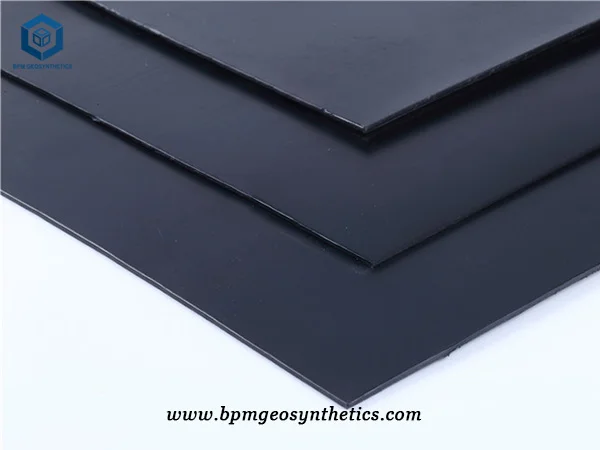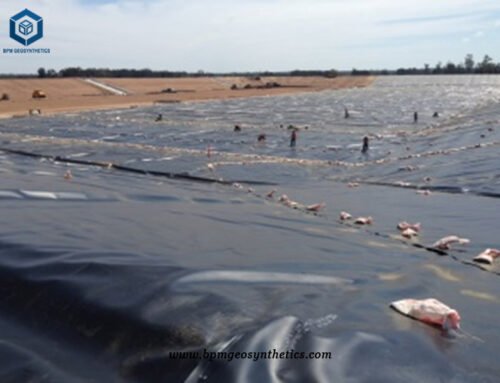Landfill membrane, also knwon as landfill geomembrane, is the geomembrane liner used in the landfill liner system. The landfill membrane is often made of HDPE (high density polyethylene) material and thicker than 1mm or 40 mils that is flexibile, durable and ability to withstand temperature changes, and high resistance to many contaminants.
As the geomembrane manufactuer and supplier, BPM Geosynthetics offers high quality landfill HDPE geomembrane in custom thickness and sizes at competitive facrory price.
1. What Is Landfill Membrane?
A landfill membrane, also known as a geomembrane or liner, is used to prevent contaminant leakage in landfills. It stops waste materials from touching the soil or groundwater.
Landfill membranes are usually made from strong materials like high-density polyethylene (HDPE). They form a barrier in the landfill to reduce pollution risks.
The membrane stops leachate, a liquid from waste decomposition, from entering the soil or water. It also controls gases like methane from decomposing waste.
Using a landfill membrane is crucial for modern landfills to protect the environment and health by managing waste well.
BPM’s landfill membrane is flexible, lightweight, and resistant to temperature changes and contaminants. Our specially made membrane is light enough to use on steep slopes. BPM sets the standard for geomembrane strength, durability, and performance in tough projects like pulverized coal management.
2. What The Advantages Of BPM Landfill Membrane?
BPM landfill membranes provide effective containment and anti-seepage properties, making them suitable for use in harsh climates, complex soil conditions, and applications such as heap immersion tanks, tailings dams, and anti-seepage systems. They offer chemical resistance, durability, and reliability, contributing to better economic benefits and ecological protection in mining and industrial settings. It has the following advantages:
2.1 Good chemical resistance
BPM landfill membranes have excellent resistance to a wide range of chemicals, making them suitable for containing and protecting against chemically corrosive substances commonly found in industrial and mining applications.
2.2 Durability and toughness
These membranes are designed to be durable and tough, capable of withstanding punctures, tears, and other physical stresses that may occur during installation or in the operational phase.
2.3 UV resistance
BPM landfill membranes have good UV resistance, which means they can withstand prolonged exposure to sunlight without significant degradation or damage.
2.4 High puncture resistance
The membranes are engineered to have high puncture resistance, providing enhanced protection against sharp objects or abrasive materials that could potentially penetrate the liner.
2.5 Excellent welding capabilities
BPM landfill membranes can be field welded using hot wedge welders and extrusion welders, ensuring strong and reliable seams that are often stronger than the sheet itself. This facilitates efficient installation and reduces the risk of leaks or failures.
2.6 Cost-effective UV stability
BPM landfill membranes are UV stable, eliminating the need for additional covering materials. This reduces the overall cost of the installation and maintenance.
2.7 Various thickness options
The membranes are available in varying thicknesses, ranging from 20 to 120 mil, allowing for customization based on specific project requirements.



3. What Kind of Membrane Is Best For Landfills?
The HDPE (High-Density Polyethylene) gmembrane is widely regarded as the top choice for landfill liner systems due to its outstanding flexibility, durability, and resistance to temperature changes and various contaminants.
With over 15 years of industrial experience, manufacturers emphasize the importance of a 40 mils (0.04 inches or 1mm) thickness for landfill membranes. This thickness ensures an exceptionally low permeability level, minimizing the risk of seepage, while also providing enhanced puncture resistance. By utilizing HDPE membranes of this thickness, landfill operators can effectively contain waste materials and safeguard the environment. The HDPE membrane’s ability to withstand harsh conditions and its resilience make it the preferred option for ensuring reliable long-term performance in landfill applications.
4. Case Study of Landfill Membrane for Pulverized Coal Project In Columbia
In Columbia, a customer started a coal mining project needing an eco-friendly way to handle the coal. The 454,500 square feet (42,224 square meters) site needed protection from coal’s toxic chemicals leaking into the soil.
The project, lasting ten years, faced tough weather in Northern Columbia. It has hot summers up to 95°F (35°C) and cold winters below -60°F (-51°C). Heavy snowfall, up to 120 inches (300 cm), made construction hard.
BPM made a careful building plan. First, they made a smooth roadbed, then put down a 450 gsm non-woven geotextile layer. Next, they added a landfill liner system with a 1mm HDPE geomembrane, professionally welded. Finally, they covered it with 18 inches (46 cm) of soil.
BPM’s expert builders saved time and money for the customer. They finished before September snow in North Columbia, avoiding weather delays.
Key Details:
- Total landfill geomembrane quantity: 454,500m2
- Roll size: 7m × 50m
- Thickness: 1.5mm
5. About BPM Geosynthetics
BPM have provided many types of effective and state of the art geomembrane, geotextile and geosynthetics products to over 81 countries. Our main innovative, high quality geosynthetics products include geomembrane, geotextiles, geocell, geosynthetic clay liners (GCLs), drainage boards, geogrids, etc. BPM brand high quality geosynthetic products had been certificated by the ISO9001, ISO14001,OHSAS18001 Soncap, SASO and BV, SGS and Intertek, etc.
If you have any questions or inquiries, please contact us, we will reply as soon as possible.





